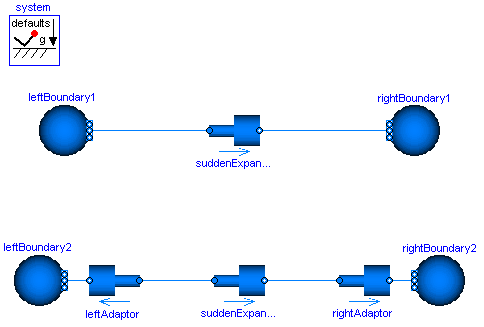This example shows the use of a sudden expansion / contraction model, which is connected to two boundary conditions prescribing static pressure. Notice that the prescribed static pressure on the right boundary is higher than on the left one. Still, the fluid flows from left to right.
The reason for this is that the boundary conditions model
infinite reservoirs with an infinite diameter and thus zero flow
velocity. The sudden expansion model does however have two ends
with finite diameters, and, as explained in the Overview of the
Users' Guide, the momentum balance is not fulfilled exactly for
this type of connections. Using a simple
connect()-statement, the difference of the kinetic
terms is neglected, which is not reasonable in the present model:
At the left boundary condition it is zero, and on the left side of
the sudden expansion it has a non-zero value. It is not reasonable
to neglect it in the shown model, because there is little friction
and therefore these kinetic effects dominate. Consequently, only
modelling these effects explicitly leads to the correct
results.
To do so, two additional sudden expansions / contractions are
included in the model. The diameter is set to inf
close to the boundaries and the proper values close to the original
model. These additional components now introduce exact
momentum balances and the results are as expected.
The total pressures offer an additional perspective on the
model. After setting the parameter show_totalPressures
on the Advanced tab of the AbruptAdaptors to
true, the total pressures are included in said models
and may be plotted. This allows to confirm that the
total pressure always reduces along the
flow direction, even in the upper model.
